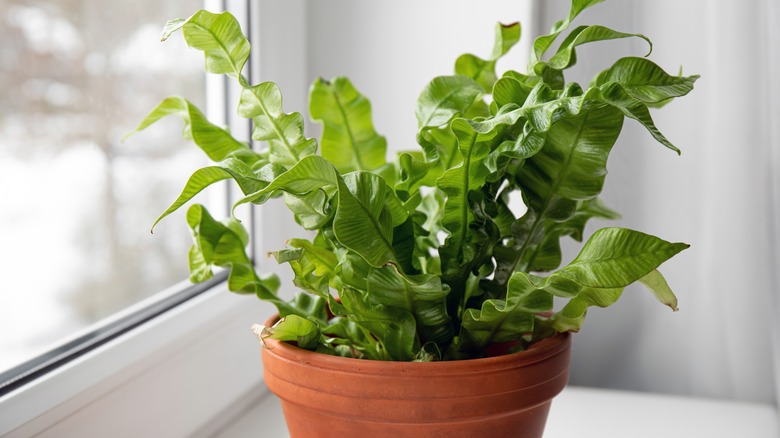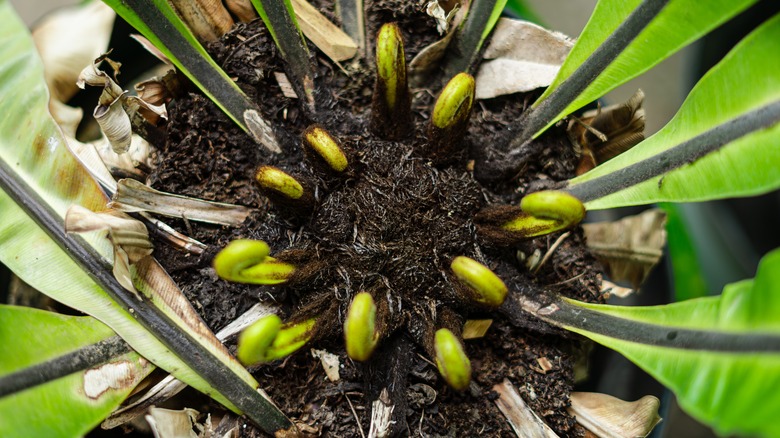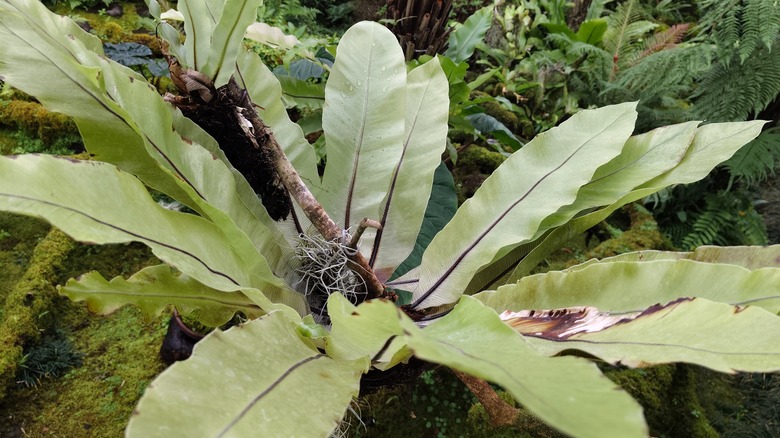How To Grow An Amazing Bird's Nest Fern Indoors Or Outdoors
The ancestors of modern ferns are among some of the oldest plants on the planet, dating back to prehistoric times. There's no need to replicate a dinosaur's habitat if you want to enjoy the fresh greenery of a fern in your home or garden; however, most early fern species have gone extinct, making way for a diverse umbrella of species which have evolved in the last 70 million years. Not all modern ferns are alike — ferns are the second most diverse vascular plant group on Earth, after all — and many have a reputation as finicky houseplants, requiring high humidity and careful sunlight calculations.
Bird's nest ferns (Asplenium nidus) have their own particularities, but they have a few characteristics that make them an attractive choice for beginner fern fanatics. They require less maintenance and can tolerate lower humidity levels than other ferns when grown indoors, and they have unique, shiny foliage that makes them stand out among their competitors. With smooth, wavy-edged fronds rather than branching, feathery fronds, bird's nest ferns take their name from the way their fronds uncurl in a rosette shape, creating a center that resembles a bird's nest. Whether you'll have better luck growing bird's nest ferns, also known as crispy wave ferns, indoors or outdoors will depend primarily on your location.
Grow a bird's nest fern indoors
Though they are a bit more needy when grown indoors vs. outdoors, the bird's nest ferns still number high on the list of ferns that could make the perfect houseplant. Since they are native to tropical regions including Hawaii, Polynesia, Southeast Asia, and Oceania, they will thrive best in areas of the home with bright indirect light and high humidity. To ensure your fern is getting adequate humidity, consider locating it in a bathroom or placing it on a water-filled pebble tray. There are a number of strategic locations where you can hang your ferns for maximum growth within an indoor space. While bird's nest ferns require plenty of moisture, their soil should be well-draining to avoid root rot when potted indoors, and they prefer nutrient-rich, loose soil. To avoid scorching, bird's nest ferns should be located away from direct-sunlight and southern-facing windows.
Bird's nest ferns are epiphytes in the wild — that is, plants which grow non-parasitically on other plants for structural support — so one growing method to consider for indoor bird's nests involves little to no soil at all. Consider wiring your bird's nest fern to a branch, rock, or fibrous slab for hanging in a high-humidity area of the home, or use a kokedama moss ball (recently featured on HGTV's "Farmhouse Fixer") to minimize soil use, if desired.
Grow a bird's nest fern outdoors
If you're looking for the largest, most dramatic foliage on your bird's nest fern, and your area meets the right hardiness conditions, it might behoove you to plant your fern outdoors. In areas where temperatures don't dip below 5 degrees Fahrenheit (USDA Zones 10-11), bird's nest ferns can be directly planted in outdoor soil in full to partial shade. Whereas houseplants typically grow up to 2 foot fronds, outdoor bird's nest ferns can grow 4 or 5 foot fronds under the proper conditions. As with indoor bird's nest ferns, outdoor bird's nest ferns can be potted in hanging baskets or containers or wired to fibrous slabs for growth on the sides of trees.
It's also possible to raise your bird's nest fern in a combination of indoor and outdoor spaces. In cooler hardiness zones, you can move your fern indoors for the winter, but move it outdoors for the hottest months of summer. Keep in mind that regardless of location, bird's nest ferns do not tolerate direct sunlight well and can be damaged by chemical insecticides. But since most ferns require less monitoring and maintenance in tropical outdoor zones than in indoor spaces, it's worth checking if your area meets the bird's nest fern's environmental requirements before committing to an indoor-only plant.


